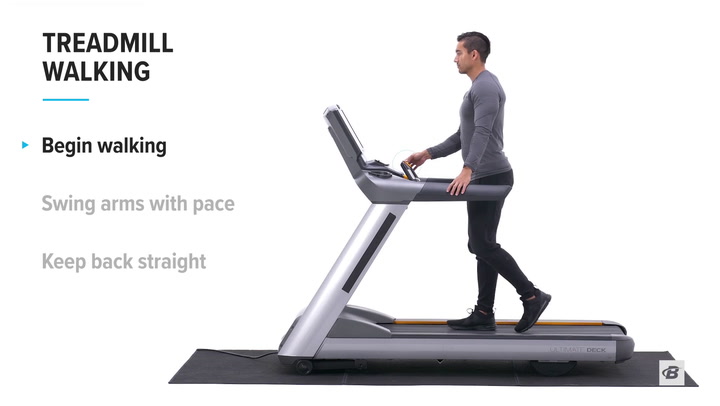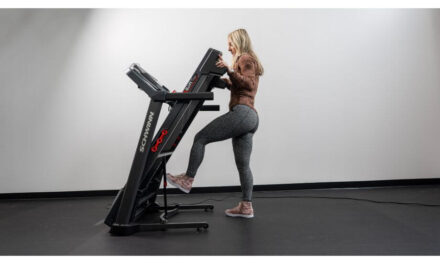If you’ve ever found yourself uncertain about how to walk on a treadmill, you’re not alone. Walking on a treadmill may seem like a straightforward task, but there are a few key things to keep in mind to ensure a safe and effective workout. In this article, we’ll walk you through the proper technique, share some tips to maximize your treadmill workout, and help you get the most out of your fitness journey. So let’s lace up our shoes and step onto the treadmill with confidence!

1. Setting up the Treadmill
1.1 Choose a suitable location
When setting up your treadmill, it is important to choose a suitable location in your home. Look for a well-ventilated area with enough space to comfortably walk on the treadmill. Avoid placing it in a cramped or cluttered space, as this can limit your movement and potentially cause accidents. Make sure there are no obstacles such as furniture or cords that could get in the way while you’re walking.
1.2 Adjust the incline
Before you start walking on the treadmill, it’s a good idea to adjust the incline to introduce some variety and challenge to your workout. Many treadmills offer adjustable incline settings that mimic walking uphill. Start with a flat surface and gradually increase the incline as you become more comfortable. Walking on an incline engages different muscles and can help burn more calories.
1.3 Set the desired speed
Set the speed of the treadmill to a comfortable level for your fitness level and goals. If you are a beginner, start with a slower pace and gradually increase as you gain strength and endurance. It’s important to listen to your body and not push yourself too hard. Remember, the goal is to maintain a consistent walking pace that allows you to continue for an extended period of time.
1.4 Familiarize yourself with the control panel
Take some time to familiarize yourself with the control panel of your treadmill. Understanding the different buttons and functions will make it easier for you to make adjustments during your workout. Most treadmills have controls for speed, incline, and preset programs. Familiarize yourself with these features to make the most out of your walking sessions.
2. Proper Walking Form
2.1 Stand straight and maintain good posture
When walking on a treadmill, it is important to maintain good posture throughout your workout. Stand tall with your head up, shoulders back, and your core engaged. Avoid slouching or leaning forward, as this can put unnecessary strain on your neck, shoulders, and back.
2.2 Engage your core muscles
Engaging your core muscles while walking not only helps improve your posture but also adds stability and strength to your workout. Draw your belly button towards your spine and consciously engage your abdominal muscles. This will help to support your spine and maintain a strong, stable foundation as you walk.
2.3 Relax your shoulders and arms
It’s important to relax your shoulders and allow them to hang naturally while walking. Avoid tensing up or hunching your shoulders. Keep your arms relaxed and swing them naturally in sync with your stride. The swinging motion of your arms helps to maintain balance and rhythm while walking.
2.4 Maintain a natural stride length
Walking on a treadmill should replicate the natural stride length you have when walking outdoors. Avoid taking overly long strides or shortening your steps. Strive for a comfortable and natural stride length that feels effortless and allows you to maintain a steady pace. This will help prevent strain on your joints and muscles.
2.5 Land softly on your feet
When walking on the treadmill, focus on landing softly on your feet with each step. Aim for a heel-to-toe motion, rolling your foot smoothly from your heel to the ball of your foot. This helps to absorb the impact and reduce stress on your joints. Avoid stomping or pounding your feet, as this can cause discomfort and increase the risk of injury.
:max_bytes(150000):strip_icc()/GettyImages-1303468837-3a8ef9ad85de4c02b603899d24b3cc80.jpg)
This image is property of www.verywellfit.com.
3. Starting the Walk
3.1 Hold onto the handrails for stability (optional)
If you are new to walking on a treadmill or feel the need for additional stability, you can choose to hold onto the handrails. However, it’s important to note that relying too heavily on the handrails can affect your posture and stride. Try to gradually decrease your reliance on the handrails as you become more comfortable and confident in your walking form.
3.2 Start with a warm-up walk
Before diving into your main walking routine, start with a warm-up walk at a slower pace. This helps to gradually increase your heart rate and warm up your muscles. Begin with 5-10 minutes of walking at a comfortable pace to prepare your body for the more intense part of your workout.
3.3 Gradually increase the speed
Once you have completed your warm-up, gradually increase the speed of the treadmill to your desired pace. If you are a beginner, start with a moderate speed and work your way up as you gain strength and endurance. Listen to your body and find a pace that challenges you without causing discomfort or fatigue.
3.4 Avoid leaning forward or backward
Maintaining proper form is crucial when walking on a treadmill. Avoid the temptation to lean forward or backward as this can throw off your balance and strain your muscles. Keep your body upright and aligned with the center of the treadmill throughout your walking session.
4. Breathing Technique
4.1 Breathe naturally and rhythmically
When walking on a treadmill, focus on breathing naturally and rhythmically. Avoid holding your breath or taking shallow breaths. Inhale deeply through your nose and exhale through your mouth. This helps to oxygenate your muscles and improve endurance.
4.2 Inhale through your nose and exhale through your mouth
A recommended breathing technique for walking on a treadmill is to inhale through your nose for a count of three, and exhale through your mouth for a count of three. This rhythmic breathing pattern helps to regulate your breathing and maintain a steady flow of oxygen to your muscles.

This image is property of content.jwplatform.com.
5. Body Alignment and Posture
5.1 Keep your eyes focused straight ahead
Maintaining proper eye position is essential for good posture while walking on a treadmill. Keep your eyes focused straight ahead, about 10-20 feet in front of you. Avoid looking down at your feet or constantly checking your progress on the console. This encourages a natural and upright posture.
5.2 Align your body with the center of the treadmill
When walking on a treadmill, align your body with the center of the treadmill belt. Avoid walking too close to the front or back of the treadmill, as this can affect your balance and increase the risk of injury. Stay centered and ensure your steps are landing in the middle of the belt.
5.3 Avoid excessive leaning or slouching
Maintain a tall and relaxed posture while walking on a treadmill. Avoid excessive leaning or slouching, as this can put strain on your back and disrupt your walking form. Engage your core muscles and imagine a string pulling you up from the top of your head to maintain an upright position.
6. Avoiding Common Mistakes
6.1 Don’t hold onto the handrails too tightly
While it’s okay to initially use the handrails for stability, avoid gripping them too tightly. Holding onto the handrails too tightly can lead to poor posture and reduce the engagement of your core and arm muscles. Gradually decrease your reliance on the handrails to improve balance and prevent dependence.
6.2 Don’t take overly long strides
Strive for a natural and comfortable stride length while walking on a treadmill. Taking overly long strides can put extra stress on your joints, particularly your knees. Maintain a moderate stride length that feels natural and allows you to maintain a smooth and continuous walking motion.
6.3 Avoid looking down at your feet
Keeping your gaze straight ahead is important for maintaining proper body alignment and posture. Avoid the temptation to constantly look down at your feet while walking on a treadmill. This can cause neck strain and disrupt your balance. Instead, focus on a fixed point in front of you to maintain good form.

This image is property of static.standard.co.uk.
7. Tracking Your Progress
7.1 Use the built-in console or fitness tracker
Take advantage of the built-in console or fitness tracker on your treadmill to track your progress. Monitor important metrics such as distance, time, and calories burned. This allows you to set goals, track your improvement over time, and stay motivated during your treadmill walks.
7.2 Set goals and monitor your distance, time, and calories burned
Setting specific goals can help you stay focused and motivated while walking on a treadmill. Whether it’s increasing your distance, beating your previous time, or burning a certain number of calories, having goals gives you a sense of purpose and accomplishment. Regularly monitor your distance, time, and calories burned to track your progress and celebrate your achievements.
8. Increasing Intensity and Challenge
8.1 Incorporate interval training
To add variety and increase the intensity of your treadmill walks, consider incorporating interval training. Interval training involves alternating between periods of higher intensity and recovery. For example, you can alternate between a brisk walk and a faster jog for set intervals of time. This helps to boost calorie burn and improve cardiovascular fitness.
8.2 Gradually increase the incline or speed
As you become more comfortable with walking on a treadmill, gradually increase the incline or speed to add challenge to your workout. This not only helps to build strength and endurance but also simulates different terrains and engages different muscles. Start with small increments and listen to your body to avoid overexertion.
8.3 Try walking uphill or adding weights
If you’re looking for an additional challenge, consider walking uphill on your treadmill. Increase the incline to mimic walking uphill, which adds intensity to your workout and targets different leg muscles. Another option is to add weights or use ankle weights to increase resistance and further strengthen your muscles.
9. Safety Precautions
9.1 Start with a proper warm-up and cool-down
Before and after each treadmill session, make sure to properly warm up and cool down your body. This helps to prepare your muscles for exercise and prevent injury. Begin with a few minutes of light stretching and dynamic warm-up exercises, such as marching in place or gentle leg swings. Similarly, at the end of your workout, gradually decrease the intensity and finish with static stretches to promote muscle recovery.
9.2 Wear appropriate footwear and clothing
Ensure that you wear appropriate footwear and clothing while walking on a treadmill. Choose supportive athletic shoes that provide cushioning and stability. Opt for comfortable, breathable clothing that allows for a full range of motion. Lacing up your shoes and dressing comfortably will enhance your overall comfort and safety during your treadmill walks.
9.3 Stay hydrated
Just like any physical activity, it’s important to stay hydrated while walking on a treadmill. Keep a bottle of water nearby and sip regularly throughout your workout. Hydrating adequately helps to prevent fatigue, cramps, and overheating. Remember to listen to your body and drink water as needed.
9.4 Use the emergency stop button if needed
In case of any unexpected accidents or discomfort, familiarize yourself with the location of the emergency stop button on your treadmill. If you ever feel unsteady or experience pain, use the emergency stop button to immediately halt the treadmill and safely step off. Prioritize safety and never hesitate to stop the machine if necessary.
10. Tips for a More Enjoyable Treadmill Walk
10.1 Listen to music or podcasts
Listening to your favorite music or podcasts can greatly enhance your treadmill walking experience. Create a playlist of upbeat and energizing songs that keep you motivated and make the time fly by. Alternatively, podcasts or audiobooks can provide entertainment and make your walks more enjoyable.
10.2 Watch TV shows or movies
Many treadmills come with built-in entertainment options such as TV screens or tablet holders. Take advantage of these features and catch up on your favorite TV shows or movies while walking on the treadmill. This can help to distract you from the physical effort and keep you engaged throughout your workout.
10.3 Use a treadmill desk for work or reading
For those who lead a busy lifestyle, incorporating work or reading into your treadmill walks can be a game-changer. Consider using a specialized treadmill desk that allows you to work on a laptop or read a book while walking. This allows you to multitask and make the most out of your workout time.
Walking on a treadmill is a convenient and effective way to improve your cardiovascular health, burn calories, and strengthen your muscles. By setting up the treadmill correctly, maintaining proper walking form, and following safety precautions, you can ensure a safe and enjoyable walking experience. Remember to start slowly, listen to your body, and gradually increase intensity as you progress. Happy walking!





